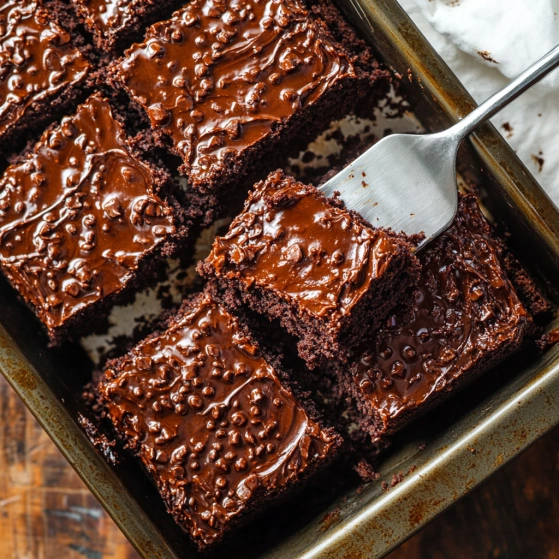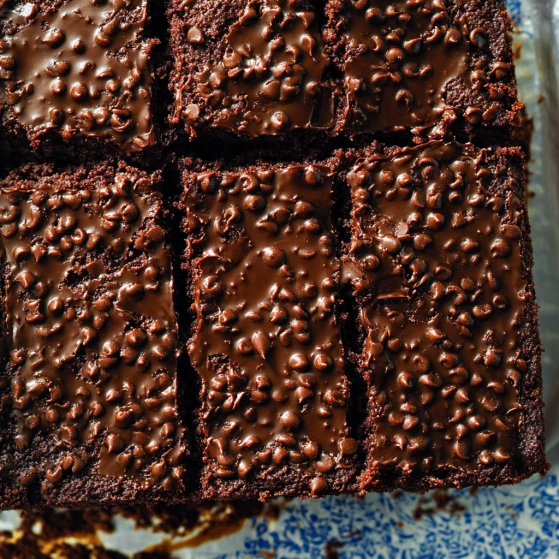 Pin it
Pin it
Texas Chocolate Sheet Cake delivers the perfect balance of rich chocolate flavor in a wonderfully moist, thin cake topped with a pourable frosting that sets into a fudgy delight. This classic Southern dessert feeds a crowd and comes together quickly, making it ideal for potlucks, family gatherings, or anytime you need to satisfy multiple sweet tooths at once. The cake's texture falls somewhere between a brownie and traditional cake, with a deeply satisfying chocolate bite that keeps everyone coming back for more.
The first time I made this sheet cake for my sister's birthday gathering, it disappeared before I could grab a second piece. My nephew actually hid a slice in the fridge behind the vegetables to save for later—that's how good it is!
Ingredients - What You'll Need
- All-purpose flour: Creates the perfect structure without being too heavy; measure by spooning into measuring cups and leveling off
- Granulated sugar: Provides sweetness and helps create that tender crumb; don't reduce this amount as it affects texture
- Unsalted butter: Use real butter (not margarine) for the richest flavor; the fat content matters for both cake and frosting
- Unsweetened cocoa powder: Dutch-processed works well but regular is fine too; sift if lumpy for smooth texture
- Buttermilk: The acidity creates tenderness and reacts with baking soda for lift; substitute with milk plus 1/2 tablespoon vinegar if needed
- Eggs: Provide structure and richness; bring to room temperature for better incorporation
- Vanilla extract: Use pure extract rather than imitation for the best flavor profile
- Baking soda: Reacts with buttermilk for proper rise; check freshness before using
- Powdered sugar: Creates that silky frosting texture; sift first to avoid lumps
- Pecans: Adds wonderful texture contrast; toast lightly before chopping for enhanced flavor
Step-by-Step Instructions
- Step 1:
- Preheat your oven to 350°F and thoroughly grease your half sheet pan, making sure to get into all corners. I find a light coating of cooking spray works perfectly, though you could use butter in a pinch. Having your pan ready before mixing ensures you can transfer the batter immediately when ready.
- Step 2:
- Combine flour, sugar, and salt in a large mixing bowl, whisking them together to distribute evenly. This step seems simple but is crucial for an evenly textured cake. Make sure your bowl is large enough to accommodate all ingredients later.
- Step 3:
- Melt butter in a medium saucepan over medium heat, watching carefully to prevent burning. Once melted, whisk in cocoa powder until completely smooth with no lumps remaining—this might take a minute of vigorous whisking. The mixture will look like thick chocolate syrup when properly combined.
- Step 4:
- Pour in the cup of boiling water (I keep a kettle ready), increase heat to medium-high, and bring the mixture to a rolling boil. Let it bubble for exactly 30 seconds—this blooms the cocoa flavor. Remove from heat immediately to prevent burning.
- Step 5:
- Pour your hot chocolate mixture over the flour mixture and stir thoroughly. This is where the magic happens—the heat partially cooks the flour and creates that signature texture. Make sure to scrape the bottom and sides of the bowl to incorporate everything.
- Step 6:
- In a separate bowl, whisk together buttermilk, beaten eggs, vanilla, and baking soda until well combined. Pour this mixture into your chocolate batter and stir just until everything is incorporated—overmixing will make the cake tough.
- Step 7:
- Pour the batter into your prepared pan, spreading it evenly to the corners. Bake for 15-20 minutes, checking at the 15-minute mark. The cake is done when the top springs back lightly when touched and the edges just start pulling away from the sides.
- Step 8:
- About 5 minutes before the cake is done, melt butter in a clean saucepan over low heat. Whisk in cocoa powder until smooth, then add milk, vanilla, and powdered sugar. Stir continuously until velvety smooth with no sugar lumps. Remove from heat and fold in chopped pecans.
- Step 9:
- Pour the warm frosting over the warm cake immediately after removing from oven. Use an offset spatula to quickly spread it to the edges before it begins to set. The warmth of both cake and frosting creates that characteristic fudgy layer that makes this cake special.
 Pin it
Pin it
My grandmother swore by pecans in this recipe. She'd gather them from the trees on her property each fall, shell them by hand, and freeze them just for making this cake throughout the year. The slight bitterness of pecans balances the sweetness perfectly, creating what she called "chocolate harmony on a plate."
The Secret Behind That Texture
The boiling water method is what sets Texas Sheet Cake apart from other chocolate cakes. This technique, sometimes called "blooming," releases and intensifies the cocoa flavor while creating a uniquely moist crumb structure. I've experimented with skipping this step and simply mixing everything together, but the results were disappointing. The boiling water process partially cooks the flour proteins before baking, creating that signature dense-yet-tender texture that's impossible to achieve otherwise. Even better, this method means you don't need to cream butter and sugar together, saving time and equipment.
Adapting For Different Occasions
Texas Sheet Cake adapts beautifully to different serving situations. For fancy gatherings, cut into precise 2-inch squares and serve on a dessert tower with fresh berries alongside. For children's parties, I've added colorful sprinkles to the warm frosting. During the holidays, I incorporate a half teaspoon of cinnamon into the cake batter and top with crushed candy canes instead of pecans. The thin profile of this cake also makes it ideal for layering – I've split the batch between two 9x13 pans, baked for less time, and stacked them with peanut butter frosting in between for birthday celebrations that drew rave reviews.
 Pin it
Pin it
Making It Ahead
This cake actually improves with a little rest, making it perfect for advance preparation. The frosting sets firmly enough to cover with foil without sticking, and the flavor compounds continue developing overnight. I often make this cake the evening before a gathering, leave it covered at room temperature, and find it's even better the next day. The moisture distribution throughout the cake becomes more even, and the flavors meld beautifully. If you need to store it longer than three days, individual slices freeze remarkably well. Wrap each piece in plastic wrap, then foil, and freeze for up to three months. Thaw at room temperature for about an hour before serving for a treat that tastes freshly made.
Frequently Asked Questions
- → Can I use a different frosting for this cake?
Yes, you can use any frosting of your choice, though the cocoa frosting with pecans adds the signature flavor and texture to this dessert.
- → Can I substitute the buttermilk?
Yes, you can use a buttermilk substitute by mixing 1 tablespoon of vinegar or lemon juice with 1 cup of milk and letting it sit for 5 minutes.
- → How do I store leftover cake?
Store leftover cake in an airtight container at room temperature for up to 2 days or in the refrigerator for up to a week.
- → Can I make this cake ahead of time?
Yes, you can bake the cake a day ahead and store it tightly wrapped. Add the frosting just before serving for the best texture.
- → Can I omit the pecans in the frosting?
Absolutely, you can leave out the pecans if you prefer or replace them with another nut or topping of your choice.
